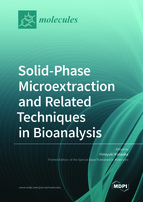Solid-Phase Microextraction and Related Techniques in Bioanalysis
A special issue of Molecules (ISSN 1420-3049). This special issue belongs to the section "Analytical Chemistry".
Deadline for manuscript submissions: closed (30 April 2022) | Viewed by 32091
Special Issue Editor
Interests: solid-phase microextraction; chromatography; advanced glycation end products; stress hormone; biomarker; heterocyclic amines; polycyclic aromatic hydrocarbons; LC–MS/MS analysis
Special Issues, Collections and Topics in MDPI journals
Special Issue Information
Dear Colleagues,
Bioanalysis of endogenous substances, drugs and their metabolites, disease biomarkers, contaminants, poisons, etc. is important in biological function analysis, metabolomics, new drug development, therapeutic drug monitoring, doping control, forensic toxicology, patient diagnosis and the biomonitoring of human exposure to hazardous chemicals. In these analyses, sample preparation is essential for the isolation and concentration of target analytes from complex biological matrices, such as serum/plasma, urine, saliva, hair, nail, sweat, exhaled breath, and tissue. However, this process is time-consuming, labor-intensive and error-prone, and markedly influences the reliability and accuracy of determining molecules of interest. Thus, efficient sample preparation techniques and their integration with various analytical instruments have become a significant challenge.
Solid-phase microextraction (SPME) is a simple and convenient sample preparation technique that has enabled automation, miniaturization, high-throughput performance, and online coupling with analytical instruments. Moreover, SPME has reduced analysis times, as well as the costs of solvents and disposal. Since SPME was first introduced in the early 1990s by Arthur and Pawliszyn, more robust fiber assemblies and coatings with higher extraction efficiencies, selectivity and stability have been commercialized. Furthermore, new geometries have been designed to use capillary tubes, magnetic stir bars or thin films for extraction devices rather than fibers, and novel intelligent polymer coatings with great sorption capacity or good selectivity have been developed as extraction phases.
This Special Issue will include a wide range of topics covering not only the development of SPME and related techniques and their applications for bioanalysis, but also the development of new extraction devices and novel intelligent coating materials available for bioanalytical, biomimetic and biocompatible sample preparation. I hope that scientists will find the selected up-to-date topics regarding sample preparation of interest, and that additional ideas and new technologies may emerge from this Special Issue.
Prof. Dr. Hiroyuki Kataoka
Guest Editor
Manuscript Submission Information
Manuscripts should be submitted online at www.mdpi.com by registering and logging in to this website. Once you are registered, click here to go to the submission form. Manuscripts can be submitted until the deadline. All submissions that pass pre-check are peer-reviewed. Accepted papers will be published continuously in the journal (as soon as accepted) and will be listed together on the special issue website. Research articles, review articles as well as short communications are invited. For planned papers, a title and short abstract (about 100 words) can be sent to the Editorial Office for announcement on this website.
Submitted manuscripts should not have been published previously, nor be under consideration for publication elsewhere (except conference proceedings papers). All manuscripts are thoroughly refereed through a single-blind peer-review process. A guide for authors and other relevant information for submission of manuscripts is available on the Instructions for Authors page. Molecules is an international peer-reviewed open access semimonthly journal published by MDPI.
Please visit the Instructions for Authors page before submitting a manuscript. The Article Processing Charge (APC) for publication in this open access journal is 2700 CHF (Swiss Francs). Submitted papers should be well formatted and use good English. Authors may use MDPI's English editing service prior to publication or during author revisions.
Keywords
- solid phase microextraction
- in-tube solid phase microextraction
- stir bar sorptive extraction
- thin-film microextraction
- microextraction in packed syringe
- solid phase dynamic extraction
- in-tip microextraction
- immunosorbents
- restricted access materials
- molecularly imprinted polymers
- porous organic frameworks
- ionic liquids
- sol–gel-based sorbents
- carbon-based sorbents
- magnetic nanoparticles
- monolithic polymers
- in vivo sampling
- biomedical analysis
- pharmaceutical analysis
- forensic analysis







